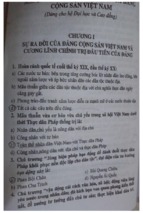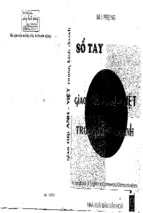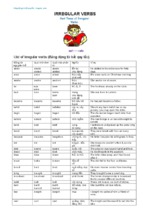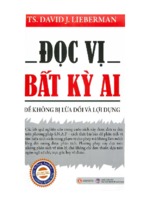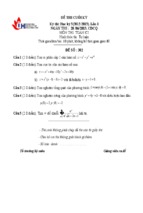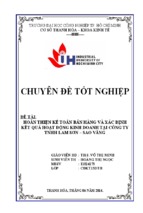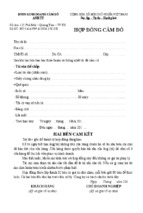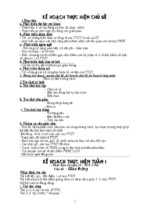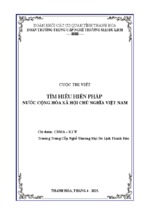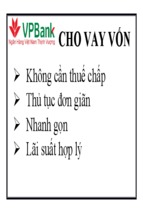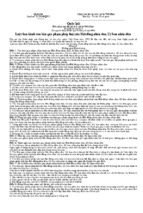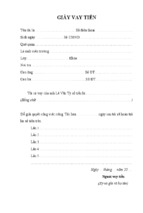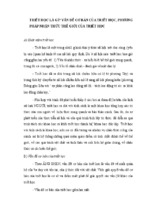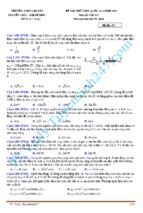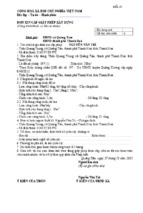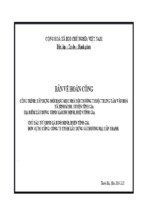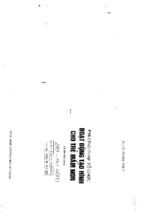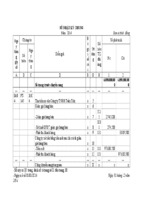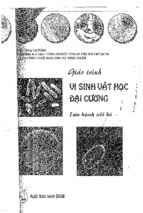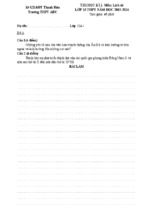NHA TRANG UNIVERSITY
Faculty of Foreign Languages
--------------
WRITING 1
Compiled by: Nguyễn Phƣơng Lan M.A
Bùi Thị Ngọc Oanh, M.A
September 2017
TRƢỜNG ĐẠI HỌC NHA TRANG
Khoa/Viện: Ngoại ngữ
1
Bộ môn:
Thực hành tiếng
ĐỀ CƢƠNG HỌC PHẦN
1. Thông tin về học phần:
Tên học phần:
-
Tiếng Việt: VIẾT 1
-
Tiếng Anh: WRITING 1
Mã học phần:
Số tín chỉ: 2
Đào tạo trình độ: Đại học
Học phần tiên quyết: Trình độ tiếng Anh sơ cấp (A1 +)
2. Mô tả tóm tắt học phần:
Học phần cung cấp cho người học cấu trúc câu, kỹ năng viết câu cơ bản để viết một đoạn
văn ở cấp độ đơn giản với lượng từ vựng và cấu trúc ngữ pháp còn hạn chế. Người học
cũng nắm vững những lỗi hay gặp trong viết câu và ý thức tự sửa những lỗi sai. Sau khi kết
thúc học phần, người học có kỹ năng viết đạt cấp độ A2+ theo chuẩn Châu Âu (CEFR).
3. Mục tiêu:
- Giúp người học có đủ kiến thức (cấu trúc, ngữ pháp, v.v...) và kỹ năng cần thiết để viết
được các loại câu, đoạn văn đơn giản về các chủ đề được yêu cầu hoặc về các lĩnh vực
quan tâm, yêu thích.
- Giúp người học thực hành các dạng bài tập chuyển đổi câu như: xây dựng câu, viết lại
câu v.v.
- Giúp người học có thể viết các văn bản đạt trên bậc 2 (tương đương A2+ của khung tham
chiếu Châu Âu).
- Giúp người học có đủ kiến thức và kỹ năng cần thiết để học các học phần viết tiếp theo.
4. Kết quả học tập mong đợi (KQHT):
Sau khi học xong học phần, sinh viên có thể:
a) Nhớ được các cấu trúc câu cơ bản trong tiếng Anh và viết được các câu cơ bản
b) Phân biệt được câu đơn, câu ghép, câu phức và viết được các câu này
c) Nhận biết các lỗi sai trong viết câu và tránh được nhưng lỗi này.
d) Tích cực tham gia vào các hoạt động trong giờ học; hợp tác làm việc theo
cặp/nhóm
e) Có ý thức tự học và tự rèn luyện, làm bài tập ở nhà để nâng cao kỹ năng viết
5. Nội dung:
STT
1
Chương/Chủ đề
Giới thiệu chương trình
2
Số tiết
Nhằm đạt
KQHT
LT
TH
A, b, c, d, e
2
0
Cách học môn Viết 1
2
a, d, e
10
0
b, d, e
6
0
a, b, c, d, e
12
0
Các mẫu câu cơ bản
Viết các câu về chủ đề quen thuộc áp dụng các mẫu câu
cơ bản
3
Các loại câu
Phân biệt được các loại câu
4
Các lỗi sai thường gặp trong câu
6. Tài liệu dạy và học:
TT
1
2
3
4
Tên tác
giả
Charles
Miguel
Cobb
Alice
Oshima
John
C.Hodges
Dorothy E.
Zemach &
Lisa
A.
Rumisek
Tên tài liệu
Process and
Pattern
Năm
xuất
bản
1996
Writing
2003
Academic
College
1996
Handbook
Academic
2008
writing
from
paragraph
to
essay
Địa chỉ
khai thác
tài liệu
Nhà xuất bản
Wadsworth
Pulishing
Company
Graw Hill
Companies
Harcourt Brace
Jovanovich,Inc.
NXB Đồng Nai
Thư viện
Nhà sách
Mục đích
sử dụng
Tài
liệu
chính
Tham
khảo
x
x
Nhà sách
x
Nhà sách
x
7. Đánh giá kết quả học tập:
Hình thức đánh giá
STT
Nhằm đạt KQHT
Trọng số (%)
b,c
30
1
Điểm kiểm tra giữa kỳ
2
Tiểu luận
a
10
3
Điểm chuyên cần/thái độ
b
10
4
Thi kết thúc học phần:
a, b, c
50
NHÓM GIẢNG VIÊN BIÊN SOẠN
(Ký và ghi họ tên)
Th.s Bùi Thị Ngọc Oanh
Ths. Nguyễn Phương Lan
Ths. Trần Thị Cúc
3
TRƢỞNG KHOA/VIỆN
(Ký và ghi họ tên)
TRƢỞNG BỘ MÔN
(Ký và ghi họ tên)
Ths. Võ Nguyễn Hồng Lam
Ths. Lê Hoàng Duy Thuần
4
Subject details
Subject name
WRITING 1
Units of credit
2
Study length
15 weeks
Prerequisite / Co
requisite
Suggested study
Commitment
Term
Pre-intermediate level
Subject Coordinator/
Lecturers
Contact details
Nguyễn Phương Lan
Bùi Thị Ngọc Oanh
Email:
[email protected]
Tel: 0983729979
Email :
[email protected]
Tel : 0903544668
Approximately 2 class hours per week
1/2017
Proposed schedule
Time
Week 1
2 periods
Week 2
2 periods
Week 3
2 periods
Week 4
2 periods
Week 5
2 periods
Week 6
2 periods
Content
Introduction the subject
Part One: The Five Basic Sentence Patterns
Part One: The Five Basic Sentence Patterns
Part Two: Sentence Structures
Part Two: Sentence Structures
Part Three: Sentence Problems
1. Parallelism
Week 7
2 periods
Week 8
2 periods
Week 9
2 periods
Week 10
2 periods
Week 11
2 periods
Week 12
2 periods
2. Punctuation
3. Sentence fragments
4. Run-on sentences and Comma Splices
5. Choppy sentences
6. Stringy sentences
Practice: transformation; sentence-building
5
Week 13
2 periods
Week 14
2 periods
Week 15
2 periods
Practice: transformation; sentence-building
Practice: Free writing
Revision
Mid term test
TABLE OF CONTENTS
PART ONE:
THE FIVE BASIC SENTENCE PATTERNS
PART TWO:
SENTENCE STRUCTURES
PART THREE: SENTENCE PROBLEMS
1. Parallelism
2. Punctuation
3. Sentence fragments
4. Choppy sentences
5. Run-on sentences and Comma Splices
6. Stringy sentences
PART FOUR: FREE WRITING (PRACTICE)
6
PART ONE: THE FIVE BASIC SENTENCE PATTERNS
Pattern One:
SUBJECT
+
VERB (Intransitive)
1. The train
has arrived.
2. The birds
are flying.
3. Dead leaves
fall.
Extending pattern one:
1. The train has arrived early.
2. The birds are flying to the South.
3. Dead leaves fall on the ground.
Exercises:
I. Translate the following sentences into English, using pattern one (S + V)
Pattern Two:
SUBJECT
+
VERB
+
COMPLEMENT
N1
LV
N1
1. I
am
a scuba diver.
2. The books
have been
the best sellers.
3. My class president
is
a girl.
4. my father
may become
chief engineer.
5. His uncle
used to be
a footballer.
b)
N
LV
AJD
1. Love
is
blind.
2. She
appears
sad.
3. His trip
sounded
interesting.
4. Her dream
has come
true
Note: * N1 denotes that two noun as the subject and the complement of the base sample
sentences say a thing or a person.
* Complement is used to define, explain or clarify the subject. It is also called
Subjective complement (SC)
* Some other forms of Subjective Complement:
1. The car was mine.
(POSSESSIVE PRONOUN)
2. The girl looked puzzled.
(PAST PARTICIPLE)
3. The news is dissappointing.
(PRESENT PARTICIPLE)
4. Seeing is believing.
(GERUND)
5. He seems to understand quite well. (INFINITIVE)
6. She is twenty.
(NUMERAL)
7. Alice is like her farther.
(PREPOSITIONAL PHRASE)
8. The meeting is here.
(ADVERB OF PLACE)
9. The meeting is at 2.30.
(ADVERB OF TIME)
10. Who is it?- It’s me / him / her / us ..(PERSONAL PRONOUN)
11. That is what I wanted to do.
(CLAUSE)
a)
Exercises:
I. Translate the following sentences into English, using pattern one (S + V+ C)
Pattern Three:
SUBJECT
+
VERB(transitive) +
7
OBJECT
1.
2.
3.
4.
5.
6.
N1
Most boys
John
Dr Fleming
The store
NhaTrang
Carelessness
V
like
dislikes
won
guarantees
attracts
causes
N2
football.
my father.
the Nobel Prize.
my TV set.
many tourists.
accidents.
Enlarging Pattern Three: The key components are capitalized
7. THE young MAN on the corner SHOUTED AN ORDER angrily.
8. YOU STARTLED ME with that unearthly shout.
9. NEWSPAPERS in urban and rural communities INFLUENCE different
PEOPLE in different ways.
10. THE little GIRL standing on the sidewalk RECOGNIZED THE fat
MAN riding on a horse.
Exercises:
I. Translate the following sentences into English, using pattern one (S + V+ O)
1.Chính phủ tuyên bố lệnh ân xá cho tất các tù nhân chính trị.
----------------------------------------------------------------------------------------2. Vị thủ tướng đã cải tổ nội các của mình.
-----------------------------------------------------------------------------------------3. Thành phố phải giải quyết những vấn đề kinh tế xã hội.
-----------------------------------------------------------------------------------------4. Cho một buổi tiệc, bạn nên ăn mặc đẹp.
-----------------------------------------------------------------------------------------5. Tổng thống đã phủ quyết dự luật này.
-----------------------------------------------------------------------------------------Pattern Four:
SUBJECT + VERB +
INDIRECT OBJECT + DIRECT OBJECT
N1
V
N2
N3
1. The sergeant
taught
the recruits
their duties.
2. The bank
promise
the firm
a loan.
3. The firm
gave
Sam
a gold watch.
4. The salesman
offered
the housewife
a free hair brush.
5. His father
left
the young boy
a large fortune.
6. The man
asked
the boy
some questions.
* Pattern four can be transferred to Pattern Three by using a preposition before the
indirect object to form a prepositional phrase or a modifier. Sentences 3, 5, 6 can be
rewritten as follows:
3. The firm
gave
a gold watch
to Sam.
5. His father
left
a large fortune
for the young boy.
.
* Verbs followed by TO:
advance
forward
lend
play
rent
sing
accord
give
mail
post
repay
take
award
grant
offer
promise
sell
teach
bring
hand
owe
quote
send
tell
deal
pass
read
serve
throw
feed
leave
pay
recommend show
write
8
* Verbs followed by FOR:
bring
choose
build
cook
buy
cut
call
design
cash
do
find
fix
get
keep
leave
* Verbs cannot be followed by TO, FOR:
ask
charge
deny
allow
cost
refuse
mix
order
paint
play
pour
reach
reserve strike
save
secure
set
envy
wish
forgive
* Some verbs can only be used in the pattern V + O + “to” +Noun / Pronoun
ask
charge deny
envy
forgive
allow
cost
refuse
wish
explain
confess
demonstrate entrust
announce
describe
introduce
prove
speak
report
declare
dictate
repeat
suggest
EX: He explained the situation to me.
He confessed his crime to the court.
Pattern Five:
SUBJECT
+
VERB
+
OBJECT
spare
take
write
win
add
propose
say /
mention
+ COMPLEMENT
N1
V
N2
N2
1. The class
elected
Sue
president.
2. The girl
called
the youngman
a fool.
3. They
have made
Richarrd
captain of the football team.
Note: The two nouns following the verb in this pattern refer to the same person or thing.
Therefore they are called N2. One is an object and the other is OBJECT COMPLEMENT
( or Objective Complement).
* Some other forms of OBJECT COMPLEMENT:
1. The boy made the teacher angry.
(Adjective)
2. I found her weeping.
( Present participle)
3. I saw him asleep.
(Adverb)
4. His threat filled me with terror. ( Phrase)
5. We have made him what he is.
( Clause)
Exercises:
I. Translate the following sentences into English, using pattern one (S + V + IO +DO)
1. Moät ngöôøi laï ñöa cho coâ ta moät laù thö vaøo saùng nay.
_________________________________________________
2. Cha meï anh ta ñaõ choïn cho anh ta moät coâ vôï ñeïp.
_________________________________________________
3. Ngöôøi caûnh saùt ñaõ chæ cho oâng aáy ñöôøng ñeán nhaø ga.
____________________________________________
4. Coâng ty ñaõ höùa seõ taêng löông cho coâng nhaân.
_________________________________________________
5. Chuùng toâi ñaõ chuaån bò cho baïn moät böõa aên nheï.
_________________________________________________
II Translate the following sentences into English,using pattern one (S +V +O +to+
Prepositional object)
1. Coâng ty ñaõ trao coâng vieäc ñoù cho ngöôøi khaùc roài.
9
_________________________________________________
2. Anh ta chuyeàn boùng cho caàu thuû bieân.
_________________________________________________
3. Xin oâng vui loøng ñöa thö naøy cho ngöôøi thö kyù.
_________________________________________________
4. Coâ aáy daïy vaät lyù vaø hoaù hoïc cho hoïc sinh taïi tröôøng ñòa phöông.
_________________________________________________
5. Baïn coù theå ñeå vieäc naáu aên cho toâi.
_________________________________________________
III. Translate the following sentences into English,using pattern one (S + V + O + for
+Prepositional object)
1. Anh ta seõ mua moät moùn quaø cho ngöôøi baïn gaùi nhaân ngaøy Valentine.
_________________________________________________
2. Anh ta roùt theâm saâm banh cho nhöõng vò khaùch.
_________________________________________________
3. Coù ngöôøi ñaõ ñeå laïi cho oâng böùc thö naøy.
_________________________________________________
4. Coâ aáy ñaõ pha caø pheâ cho taát caû chuùng toâi.
_________________________________________________
IV. Translate the following sentences into English,using the verbs : allow, charge,
cost, deny
1. Hoï chuùc chuùng toâi moät chuyeán ñi thuù vò.
_________________________________________________
2. Cheá ñoä aên kieân naøy cho pheùp anh uoáng moãi ngaøy moät coác röôïu.
_________________________________________________
3. Hoï tính tieàn cho toâi theo giaù môùi.
_________________________________________________
4. Giôùi chuû nhaân töø choái quyeàn sô daúng cuûa giôùi thôï.
_________________________________________________
10
PART TWO:
SENTENCE STRUCTURES
A.THE DEFINITION
.
What is a
Sentence?
A sentence is a group of words that contains a subject and a
verb and expresses a complete thought.
These are sentences:
1. He is a student.
2. It’s hot today.
3. He looks tired.
4. Are you hungry?
5. Who’s there.
6. The man bought a new car.
7. Does your sister live with you?
8. Hurry! ( The subject in this sentence is “YOU”)
These are not sentences:
9. Hot weather. (There is no verb)
10. The man bought. (This is not a complete thought)
11. Is very handsome. (There is no subject)
PRACTICE:
Work with a partner.
Recognizing 1. Read each group of words our loud.
Sentences
2. Decide which ones are complete sentences and which ones are not.
3. Write yes next to the complete sentences and no next to the
non sentences.
4. Explain why the non sentences are not sentences
Examples:
No
Is very hot today. (There is no subject
)
Yes
It is very hot today. ( _____________________________)
1. _____ My new classmate from Brazil. (__________________________)
2. _____ He speaks three languages fluently.
3. _____ Is very handsome.
4. _____ When arrive here.
5. _____He wants to start his own business.
6. _____He isn’t married.
7. _____Enjoys many sports, especially soccer.
8. _____Don’t worry.
Subjects and Verbs
Subject and verbs are the most important parts of a sentence. In English, the
subject of a sentence is always expressed except in a command: Hurry! (We
know that the subject is “you”)
The subject tells who or what did something. It is a noun or pronoun
The verb often tells the action. However, sometimes a verb doesn’t tell an action.
Sometimes it just links the subject with the rest of the sentence.
Action verbs:
The car hit the pedestrian.
My family lives in a two-bed room apartment.
11
My roommate lost his car keys.
Linking verbs:
Skiing is my favorite sport.
I feel sick.
You look hungry.
The most common linking verbs are be, become, feel, look, seem, smell, sound, and taste.
PRACTICE: Work with a partner.
Finding Subjects
1. Underline the subjects with one line.
And Verbs
2. Underline the verbs with two lines.
3. Write S or V above each underlined word.
Examples:
My little brother is in the fifth grade.
He watched TV and does his homework at the same time.
1. My best friend is single.
2. He likes his job but hates his boss.
3. He didn’t go to work yesterday.
4. This semester, he is studying English and computer science.
B. SENTENCE STRUCTURES
I. Simple Sentences
There are four basic kinds of sentences in English: simple sentences, compound sentences,
complex sentences, and compound-complex sentences.
A simple sentence is a sentence that has one-subject-verb combination.
The subject in a simple sentence may be compound (My brother and I). The verb may be
also compound (The laughed and cried). What is important is that there is only one
subject-verb combination in a simple sentence.
These are simple sentences. Notice that no commas are used in them.
1. My younger sister speaks English well.
2. My mother and father speak English well.
3. My mother and father speak and write English well.
The simple sentences above can be written as formulas.
SV- simple subject with simple verb
SSV- compound subject with simple verb
SVV- simple subject with compound verb
SSVV- compound subject with compound verb
PRACTICE:
A. Work by yourself or with a partner. Identify the pattern in the
Simple sentence
following simple sentences.
Patterns
1. Underline the subjects with one line.
2. Underline the verbs with two lines.
3. Write S or V above each underlined word.
4. Finally, write the formula for the sentence in the numbered space below
Example:
My grand father loves to fish and often takes me with him to his favourite fishing place.
Formula: SVV
12
My grand father
1
My grand father is old in years but young in spirit. 2Everyday, he swims a mile
and works in his garden, 3He and my grandmother were married fifty years ago. 4They
have four children and ten grandchildren. 5My grand father loves parties and invites our
entire family to his house for a big dinner on his birthday. 6All twenty of us eat and tell
stories half the night. 7He never gets tired and is always the last to go to bed. 8On his last
birthday, my brothers and I gave him a present. 9We all put our money together and
bought him a video game system.
10
Now he wants us to come over to his house every
weekend
1. ______
2. ______
3. ______
4. ______
5. ______
6. ______
7. ______
8. ______
9. ______
10. ______
II. Compound Sentences
A compound sentence is two simple sentences connected by a comma
and a coordinating conjunction.
Here is the formula for a compound sentence:
Simple sentence
,
coordinating
conjunction
Simple sentence
Notice that a compound sentence has a comma before the coordinating conjunction.
A coordinating conjunction is a type of connecting word. There are only seven
coordinating conjunctions in English. We will practice four of them: and, but, or, so.
These are compound sentences:
Simple sentence
coordinating
conjunction
1. My family goes camping every summer, and
2. We want to go to Hawaii soon,
so
3. Next year we will take a cruise,
or
4. Last year we went camping at Blue Lake, but
Simple sentence
we usually have fun.
we need to save money.
we may just stay at home.
we had a terrible time.
It is possible to connect three simple sentences. (Don’t connect more than three, however,
and don’t use the same conjunction twice)
Simple sentence , but simple sentence, so simple sentence
Ex: We love to camp, but last year we didn’t enjoy it, so this year we will do something
different during our vacation.
Compound
Sentences
versus simple
sentences
with
compound
Compare the two pairs of sentences below. The first of each pair of
sentences is simple and doesn’t need a comma. The second one is
13
PRACTICE:
Simple
versus
Compound
Sentences
simple
compound and requires a comma.
Simple sentence with My family goes camping every summer SVV
Compound verb:
and usually has fun.
Compound sentence: My family goes camping every summer, SV, and SV
and we usually have fun.
Simple sentence with Last year we went camping but
SVV
Compound verb:
had a terrible time.
Compound sentence: Last year we went camping, but
SV, but SV
We had a terrible time.
A. Work by yourself or with a partner.
The sentences in this exercise explain some of the rules of
American football
1. Underline the subjects with one line and the verbs with two lines.
2. Write “simple” or “compound” in the space at the left of each sentence.
Example:
One team kicks the ball to the other team to start the game.
1.
The quarterback is the most important player on the team.
2.
The quarterback can throw the ball or run with it.
3.
with it.
The quarterback can throw the ball, but the other players can only run
4.
Then the other team gets the ball, and it is their turn to try to make a touchdown.
5. ______ The offensive team can also kick the ball between the goal posts of the other
team to score points.
B. Work by yourself or with a partner
1. Analyze each sentence in the following paragraphs. Underline the subjects with one line
and the verbs with two lines.
2. Write simple or compound in the numbered spaces.
3. Then write the formula for each sentence: SV, (and) SV or SVV or SSV and so fourth.
4. Add a comma to each compound sentence. Sentence number six is a command, so the
subjects are not expressed. (You will need to add a total of five commas in the two
paragraphs.)
How To Clear Your Ears In An Airplane
1
Sometimes passengers’ ears hurt in an airplane. 2This pain can be quite
strong. 3It is caused by unequal air pressure outside and inside your ears. 4The air
pressure in the airplane may be at 15,000 feet but the air pressure inside your ears
is still at ground level. 5Airlines recommend the following techniques to stop the
pain. 6Pinch your nose closed with your fingers and pretend to blow your nose.
7
This action makes the pressure equal and usually stops the pain. 8You can also
yawn several times or you can swallow hard. 9Children can chew gum and babies
can suck on a bottle or a pacifier.
14
1. simple
SV
6. _____________
________
2. _____________
________
7. _____________
________
3. _____________
________
8. _____________
________
4. _____________
________
9. _____________
________
5. _____________
________
PRACTICE:
Writing
Compound
Sentences
Work with a partner.
A. 1. Connect the two simple sentences in each pair to make a compound
sentence. Connect them with and, but, or, so- whichever best fits the
meaning. (There may be more than one possible choice .)
2. Be sure to add commas.
Example:
Canada has two official languages. Government documents are printed in both English
and French.
Canada has two official languages, so government documents are princed in both English
and French.
LANGUAGE FACTS
1. There are several hundred languages in the world. Not all of them have a written form.
____________________________________________________________________
2. Languages have symbols for sounds. They use symbols for ideas. (use or.)
____________________________________________________________________
3. English uses sound symbols. Chinese uses idea symbols.
____________________________________________________________________
4. Chinese is spoken by more people. English is spoken in more countries.
____________________________________________________________________
5. Russian is the third most spoken language in the world. Spanish is the fourth.
____________________________________________________________________
6. There are about one million words in English. Most people only use about ten thousand
of them.
____________________________________________________________________
7. Chinese has many different dialects. Chinese people cannot always understand each
other.
____________________________________________________________________
8. French used to be the language of international diplomacy. Now English is used more
often.
B. Make compound sentences by adding a SV combination to each of the following.
Example: A good boss has a sense of humour, and he (or she) is always fair.
1. A good husband comes home from work in a cheerful mood, and ……………………
2. A good wife has a part-time job, but…………………………………………………
3. An ideal teacher gives take-home tests, or………………………………………
4. Good parents want to raise healthy children, so………………………………………
15
C. Write compound sentences of your own. Use each of these coordinating
conjunctions once: and, but, or and so.
5. A good employee
___________________________________________________________
6. A good student
_____________________________________________________________
7. An ideal roommate
____________________________________________________________
8. A best friend
_______________________________________________________________
III. Complex Sentences
In part A and B you learned about simple and compound sentences. A third kind of English
sentence is a complex sentence. Before we study these let’s learn about clauses.
INDEPENDENT and DEPENDENT CLAUSES
A clause is a group of words that contain a subject and a verb. There are two kinds of
clauses in English: independent clauses and dependent clauses.
Independent clause
Dependent clause
It rained.
…because it rained…
An independent clause has one SV combination and expresses a complete
thought. It can be a sentence by itself. A simple sentence is an independent clause.
Ex: Paris has excellent art museums.
It was cold and windy yesterday.
We finished our homework and cleaned up the kitchen.
A dependent clause is an independent clause with a subordinating conjunction
added to the beginning of it.
Ex: …because it has excellent art museums…
…although it was cold and windy yesterday…
…after we finished our homework and cleaned up the kitchen…
A dependent clause does not express a complete thought, so it is not a sentence by
itself. It needs to be joined to an independent clause to make sense.
Independent clause
Dependent clause
Art students should visit Paris because it has excellent art museums.
We went on a hike although it was cold and windy yesterday.
We watched TV after finished our homework and cleaned up the kitchen.
16
Subordinating Conjunctions There are many subordinating conjunctions. Some
introduce reasons, some introduce times, and others introduce contrasts and conditions. A
few of them are listed below, and a more complete list is in Appendix B.
SUBORDINATING CONJUNCTIONS
Reason
because
Time
before
after
Contrast
when
while
Condition
although
if
We cancelled our picnic because it rained.
Wait for a green light before you cross the street.
I will go straight to bed after I finish this exercise.
Where were you when I called?
My neighbors were having a party while I was trying to sleep.
My father doesn’t speak English although he lived in England for many years.
I will be happy if I win the lottery.
Here are some things to remember about subordinating conjunctions.
1. A few subordinating conjunctions are also prepositions.
after my accident (Preposition)
after I had an accident (subordinating conjunction)
before class (preposition)
before class begins (subordinating conjunction)
2. Because is a subordinating conjunction. Because of is a two-word preposition.
because of my accident (preposition)
because I had an accident (subordinating conjunction)
3. Although introduces a contrast conjunction. It has about the same meaning as but.
Although they didn’t study, they passed the test. (They didn’t study, but they
passed the test anyway.)
Although I was tired, I couldn’t go to sleep. (I was tired, but I couldn’t go to
sleep.)
Although the weather was bad, they went on a picnic. (The weather was bad, but
they went on a picnic anyway.)
4. If introduces a condition.
If you don’t study, you will fail the text.
If it rains, we will cancel our picnic.
If you visit my country, you should spend several days in the capital.
17
Work with a partner.
PRACTICE:
ID and DC
clauses
1. Write IC (independent clause) OR DC (dependent clause) in the space
to the left of each group of words.
2. If it is a DC, circle the subordinating conjunctions.
Example:
DC
While
the class was taking a test.
1. ____ I take a walk around the block.
2. ____ Before I go to work.
3. ____ This exercise wakes up my body and clears my mind.
4. ____ It’s hard to do this in the winter.
5. ____ Because it is still dark when I go to work.
6. ____ Although I try to get up early even on weekends.
7. ____ I sometimes sleep late on Saturdays.
8. ____ When it is raining, of course.
9. ____ I never go out.
Complex
Now let’s learn about complex sentences.
Sentences
A complex sentence has one independent clause and one or more
dependent clauses.
The clauses into a complex sentence can be in any order. If the dependent clause is first, put a
comma after it.
Marca always gets As because she studies hard.
Because Marca studies hard, she always gets As.
I will quit my job immediately if I win the lottery.
If I win the lottery, I will quit my job immediately.
We went home after the dance ended.
After the dance ended, we went home.
We can write the formulas for simple, compound, and complex sentences as follows:
Simple sentence
Compound sentence
Complex sentence
PRACTISE
=
=
=
Or
IC
IC,
IC
DC,
co ord. conj. IC
DC
(no comma)
IC
(comma)
A. Work with a partner.
18
Complex Sentences 1. Underline the independent clauses with a solid line and the
dependent
clauses with a broken line.
2. Draw a circle around the subordinating conjunction.
3. Add a comma if one is needed.
Example:
After
I won the lottery last year, my wife and I traveled around the world.
1. We were very excited when we won the lottery.
2. After we got our first payment we started planning out trip.
3. We decided to visit Italy first because our parents came from there.
4. Before we left on our trip we wrote to our cousins in Rome.
5. Although we didn’t know our Italian cousins they invited us to stay with them.
B. Combine a dependent clause from column A with a an independent clauses from column B
to make complex sentences. You can write the clauses in either order, but be sure to
punctuate them correctly.
A
B
1. Before my two brothers and I got to the lake
a)
I always get seasick
2. Because we forgot our fishing licenses
b)
It was almost noon.
3. When I am on a boat
c)
I wasn’t catching anything.
4. If my brothers invite me to go fishing again
d)
It started to rain hard.
5. After we had been fishing for a while
e)
We had to drive back ten
6. Before we could get back to shore.
miles and buy new ones.
7. While my brothers were catching fish after
f)
I hate it
g)
I will say, “No, thank!’
fish
8. Although my brothers love fishing
h)We were wet from head to foot
1. _______________________________________________________________________
2. _______________________________________________________________________
3. _______________________________________________________________________
4 _______________________________________________________________________
5. _______________________________________________________________________
6. _______________________________________________________________________
7. _______________________________________________________________________
8. _______________________________________________________________________
19
IV. Compound-Complex Sentences
A compound-complex sentence is made from two independent
clauses and one or more dependent clauses.
Some examples:
1. Although I like to go camping, I haven't had the time to go lately, and I haven't found
anyone to go with.
independent clause: "I haven't had the time to go lately"
independent clause: "I haven't found anyone to go with"
dependent clause: "Although I like to go camping... "
2. We decided that the movie was too violent, but our children, who like to watch scary
movies, thought that we were wrong.
independent clause: "We decided that the movie was too violent"
independent clause: "(but) our children thought that we were wrong"
dependent clause: who like to watch scary movies
Practice Exercise
Identify the independent and subordinate clauses in the following sentences and determine
whether they are complex or compound-complex. You can check your answers below.
1.
2.
3.
4.
5.
Jason decided to stay up late because he had a lot of homework to do.
If you hurry, we might get to school on time.
Although Monica had a cold, she went to school because she had a test.
While washing the car, Todd slipped on the soap and he fell.
Dad takes the train to work even though he has a car.
20


